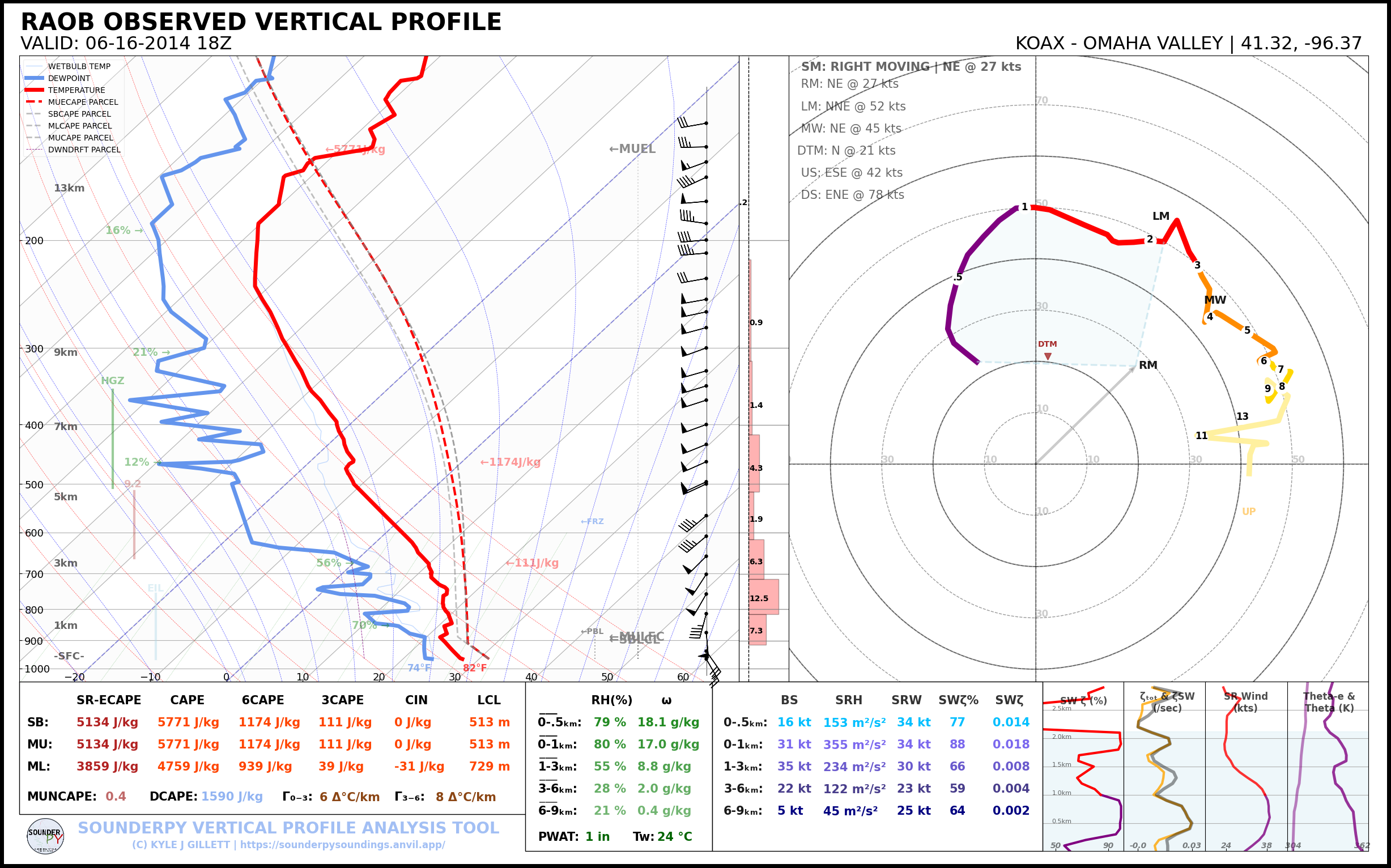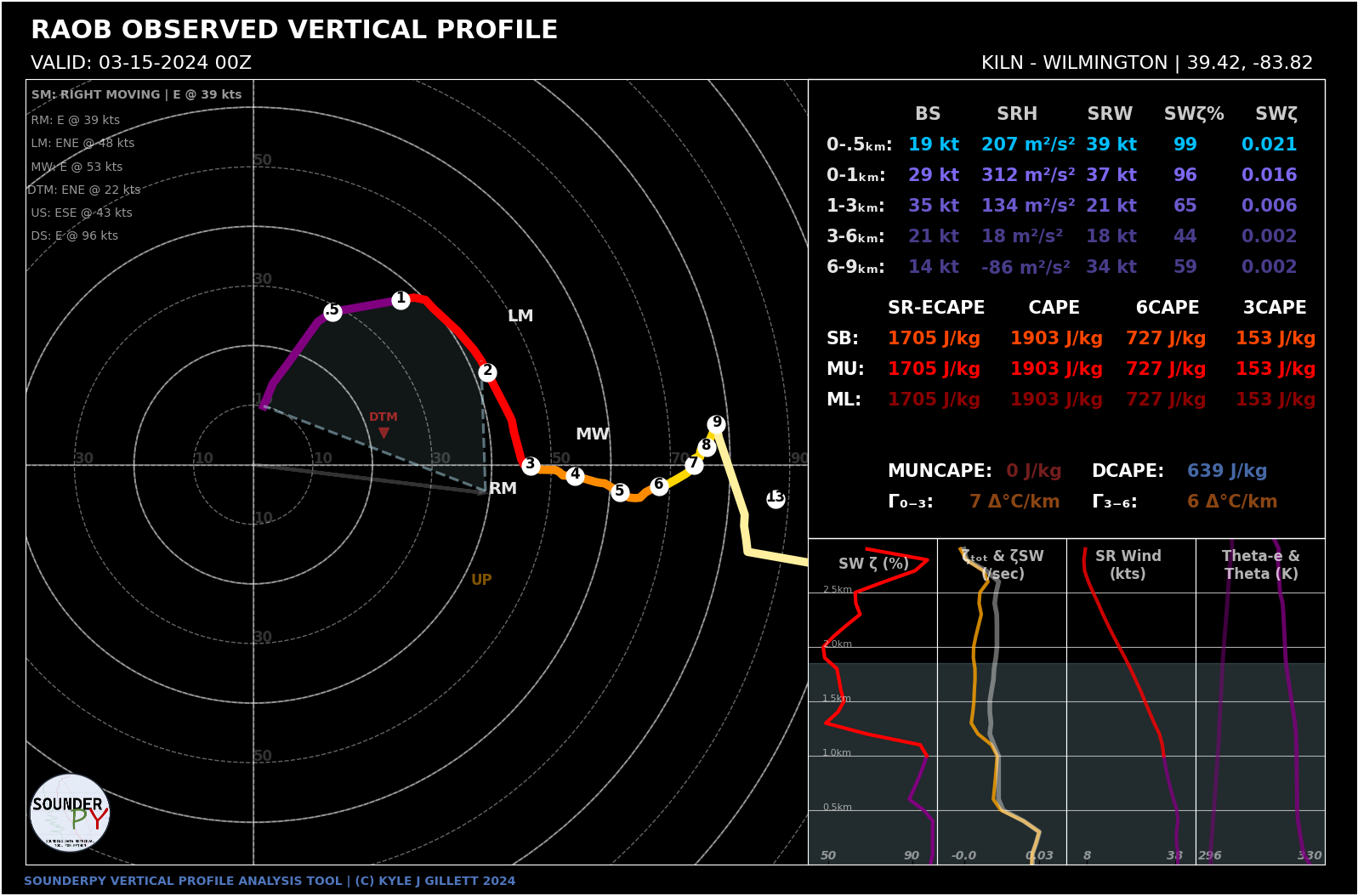Sounderpy Save
A python package that helps you to access and plot vertical profile data for meteorological analysis
SounderPy, the vertical profile data retrieval and analysis tool for Python
LATEST VERSION: v3.0.3 | RELEASED: March, 2024 | COPYRIGHT Kyle J Gillett, 2023, 2024
A Python package that helps you to access and plot vertical profile data for meteorological analysis
VISIT SOUNDERPY DOCUMENTATION | CHECK OUT AN EXAMPLES & TUTORIALS
VISIT THE OPERATIONAL SOUNDERPY SOUNDING ANALYSIS SITE
What is SounderPy:
ABSTRACT: SounderPy is a simple, open-source Python package for retrieving and plotting vertical profile (sounding) data. Built for simplicity and reliability for all uses and users, this project’s goal is to provide a uniform method for sounding analysis across multiple data types. Severe weather analysis and forecasting requires a sound comprehension of thermodynamic and kinematic properties of the environment. SounderPy makes this possible with robust access to data and custom visualizations. The tool creates complex yet effective sounding and hodograph plots with high readability which are designed specifically for severe weather analysis and forecasting. SounderPy is capable of retrieving and plotting model forecast data, observed radiosonde data, Aircraft Communications Addressing and Reporting System (ACARS) observation data, and model reanalysis data. All of this functionality can be completed in three simple lines of code or less, making SounderPy an accessible tool for both Python experts and novices. A number of scientific Python libraries build the base of SounderPy’s efficient and durable functionality, such as NumPy, Matplotlib, xarray, Metpy, and SHARPpy. SounderPy is available through GitHub and PyPi and is distributed under an MIT license.
SounderPy has been used by several institutions. For example, this tool has been implemented by the Des Moines, Columbia, and Grand Rapids National Weather Service Offices, the State University of New York at Albany, Mississippi State University, the University of North Dakota, and others. Many students at various universities have used SounderPy in projects and papers, such as students at Ohio State University, Central Michigan University & Rizal Technological University.
Why SounderPy?
- Sometimes data is tough to find, and often times it’s even tougher to get it in the format you like. SounderPy gets you this data!
- The code needed for loading and parsing meteorological data, especially from models, can be large and messy. SounderPy keeps it hidden away in a PyPi package – just import and call sounderPy functions to keep your code clean!
- SounderPy functions are designed to be simple and quick making for reliable use in research, forecast/analysis operations, and simply for fun!
What kind of data?:
| DATA | FUNCTION | TYPE | TIME RANGE |
|---|---|---|---|
| ECMWF CDS ERA5 reanalysis* | get_model_data() | Reanalysis | 1940-present |
| UNIDATA THREDDS TDS RAP | get_model_data() | Reanalysis | 2005-present |
| UNIDATA THREDDS TDS RUC | get_model_data() | Reanalysis | 2005-2020 |
| UNIDATA THREDDS NCEP-FNL | get_model_data() | Reanalysis | 2005-2020 |
| ISU's BUFKIT archive | get_bufkit_data() | Model Forecast | 2011-present |
| PSU's BUFKIT feed | get_bufkit_data() | Model Forecast | Most recent runs |
| UNIDATA THREDDS TDS RAP | get_model_data() | Model Analysis | Most recent run |
| OU ACARS Archive | acars_data() | Observations | 2019-present |
| The Unv. of WY RAOB Archive | get_obs_data() | Observations | 1973-present |
| IGRAv2 Observation archive | get_obs_data() | Observations | 1905-present |
| NWS NEXRAD AWS Archive | pyart_radar_profile() | Observations | 1990s-present |
Installation
-
Install the SounderPy software:
-
SounderPy is available on PyPi and can be installed via
pip:pip install sounderpy -
or via
conda forgeby first setting up theconda-forgechannel:conda config --add channels conda-forge conda config --set channel_priority strictthen
conda install sounderpyor
mamba install sounderpy
-
-
Import SounderPy into your Python project:
import sounderpy as spy -
Lets declare a few simple variables we can use to get data:
year = '2014' month = '06' day = '16' hour = '18' station = 'OAX' -
Get some data!
# this will get us 18z observations on June 16th, 2014 from OAX (Omaha, Neb) clean_data = spy.get_obs_data(station, year, month, day, hour)and boom! Now you have a callable dictionary of vertical profile reanalysis data including...
- Temperature
- Dewpoint
- Pressure
- Height
- U-component Wind
- V-component Wind
SounderPy can also plot profile data on unique sounding and hodograph figures!
spy.build_sounding(clean_data, color_blind=True)
spy.build_hodograph(clean_data, dark_mode=True)


To learn more about what you can do with SounderPy, check out the documentation
AUTHORS AND CONTRIBUTORS
AUTHOR: Kyle J Gillett, Central Michigan University
CONTRIBUTOR: Scott Thomas, NWS Grand Rapids | VWP Hodograph, Buoy-sites listing
CONTRIBUTOR: Amelia R H Urquhart, University of Oklahoma | ecape-parcels library
CONTRIBUTOR: Daryl Herzmann, Iowa State University | SounderPy Feedstock for conda-forge
CITING SOUNDERPY
in AMS format:
- Gillett, K., 2024: SounderPy: Vertical Profile Data Retrieval & Analysis Tool for Python (Version 3.0.3). Py-Pi, https://pypi.org/project/sounderpy/
REFERENCES
-
Harris, C.R., Millman, K.J., van der Walt, S.J. et al. Array programming with NumPy. Nature 585, 357–362 (2020). DOI: 10.1038/s41586-020-2649-2.
-
Hoyer, S. & Hamman, J., (2017). xarray: N-D labeled Arrays and Datasets in Python. Journal of Open Research Software. 5(1), p.10. DOI: https://doi.org/10.5334/jors.148
-
J. D. Hunter, "Matplotlib: A 2D Graphics Environment", Computing in Science & Engineering, vol. 9, no. 3, pp. 90-95, 2007.
-
Ryan M. May, Sean C. Arms, Patrick Marsh, Eric Bruning, John R. Leeman, Kevin Goebbert, Jonathan E. Thielen, Zachary S Bruick, and M. Drew. Camron. Metpy: a Python package for meteorological data. 2023. URL: Unidata/MetPy, doi:10.5065/D6WW7G29.
-
Ryan M. May, Sean C. Arms, John R. Leeman, and Chastang, J. Siphon: A collection of Python Utilities for Accessing Remote Atmospheric and Oceanic Datasets. Unidata. 2017. [Available online at https://github.com/Unidata/siphon.] doi:10.5065/D6CN72NW.
-
Pauli Virtanen, Ralf Gommers, Travis E. Oliphant, Matt Haberland, Tyler Reddy, David Cournapeau, Evgeni Burovski, Pearu Peterson, Warren Weckesser, Jonathan Bright, Stéfan J. van der Walt, Matthew Brett, Joshua Wilson, K. Jarrod Millman, Nikolay Mayorov, Andrew R. J. Nelson, Eric Jones, Robert Kern, Eric Larson, CJ Carey, İlhan Polat, Yu Feng, Eric W. Moore, Jake VanderPlas, Denis Laxalde, Josef Perktold, Robert Cimrman, Ian Henriksen, E.A. Quintero, Charles R Harris, Anne M. Archibald, Antônio H. Ribeiro, Fabian Pedregosa, Paul van Mulbregt, and SciPy 1.0 Contributors. (2020) SciPy 1.0: Fundamental Algorithms for Scientific Computing in Python. Nature Methods, 17(3), 261-272.
-
Marsh, P., Halbert, K., Blumberg, G., Supinie, T., Esmaili, R., Szkodzinski, J., "SHARPpy: Sounding/Hodograph Analysis and Research Program in Python." GitHub. Available at: https://github.com/sharppy/SHARPpy.






